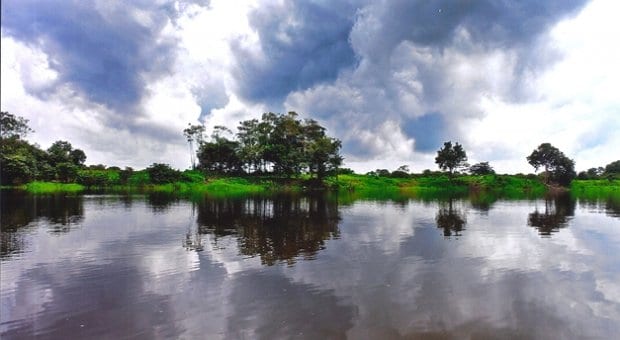
The Amazon jungle is not all thick forest. Much of it is clear land and a good part of that is cultivated. The region is filled with people who live along the banks of the Amazon River, using the myriad waterways as others use highways. Credit: Jeremy Hainsworth
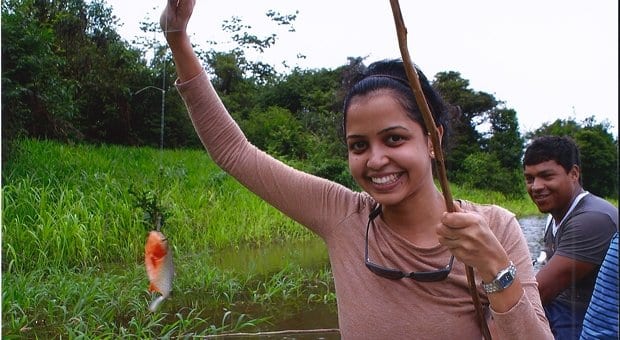
A Boston visitor to the Amazon shows off her first piranha catch to guide Shane Zammette. Beef is used as bait to catch the ferocious fish. Credit: Jeremy Hainsworth
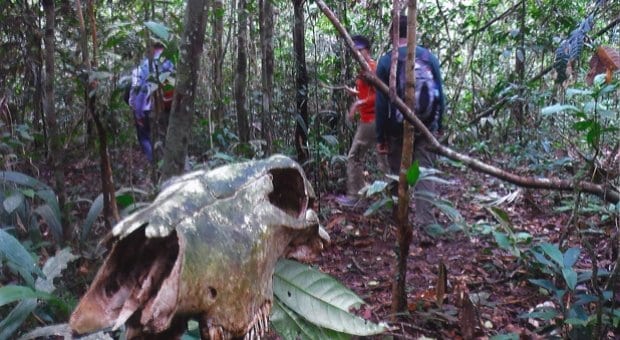
Amazon visitors hike through the jungle on a trek designed to teach survival skills. They are taught what not to touch and which plants have medicinal value and are introduced to many animal and insect species — including tarantulas, which nest everywhere. Credit: Jeremy Hainsworth
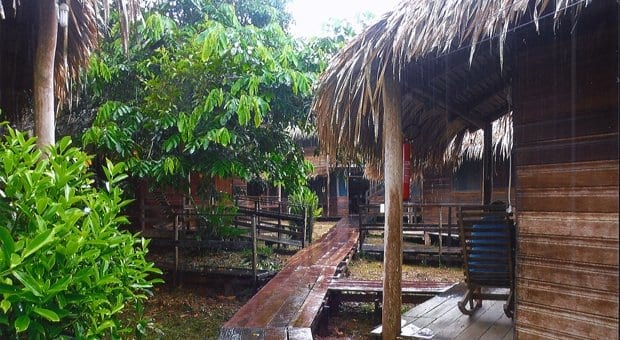
Most days just after noon, the Amazon skies open, unleashing a torrential downpour on the huts and walkways of guide operator Gero Mesquita’s Ararinha Jungle Hotel lodge. Credit: Jeremy Hainsworth
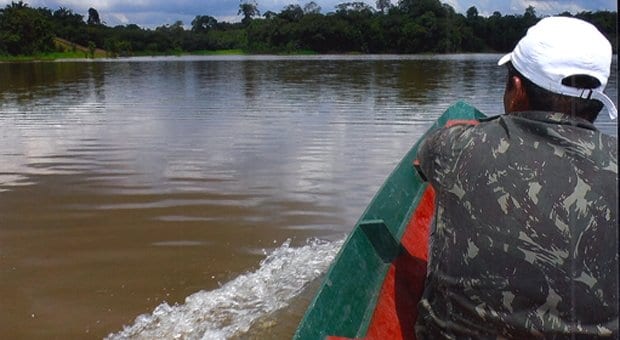
Amazon jungle guide Shane Zammette surveys the water and land from the bow of a motorized canoe. Credit: Jeremy Hainsworth
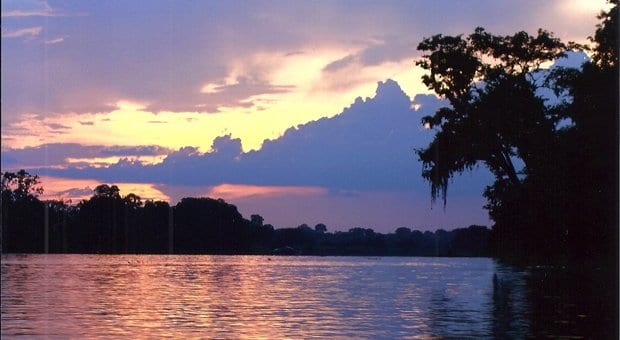
The Amazon is close to the Equator, so the sun sets quickly and magnificently, placing the water and forest in stark relief. Credit: Jeremy Hainsworth
Amazon jungle guide Shane Zammette raises his hand in the steaming forest and stops our line of six hikers.
“It smells like wet dog,” he says.
Looking at me at the rear of the line, he asks, “Do you want a machete, Jeremy? Jaguars always attack from the rear.”
I spend the next half hour watching the dense jungle around me before manoeuvring myself into the middle of the group.
“It doesn’t really matter, does it?” I later ask. “They’re silent killing machines. It would be ripping my throat out before I knew it was on me.”
Zammette nods and smiles.
The moment brings home the deadly reality of the awesome beauty around us.
It is the recognition that — amidst the tangle of tropical plants, colourful birds, huge spiders, termite mounds and caimans lunging into waters infested with piranha — life in this paradise is a precious thing in which all creatures co-exist for survival — humans included.
Visiting the Brazilian Amazon, a guide will tell you, is something that must be done after taking some lessons in survival.
I quickly learn it is essential to survey a shoreline before leaping to land a canoe because you can land on something very surprising.
And, I find myself very attentive to my movements as I move to clear my way along forest paths. By shifting a branch or vine, I could find myself clutching a spider or a snake.
Any unthinking move could prove fatal.
With those lessons in mind, I find visiting the Amazon to be an experience that dispels myths but also one that fills me with respect and awe for the largest rainforest on the planet.
Indeed, various people tell me, much of what draws visitors to the Amazon is the opportunity to venture into one of the world’s great unknowns.
“The Amazon was or is a mystery to a lot of people,” says Wolf Wink, a German who went to Brazil to pursue his dream of being a guide and now works under the name Lobinho da Silva, or Little Wolf of the Forest.
“The people who come here are interested in the culture and the nature. It’s different than all other places in the world,” Wink says.
Our group stays at a lodge run by Amazon Gero Tours, one of a number of companies operating out of the city of Manaus, at the confluence of the Rio Negro and the Solimões (the upper Amazon) River.
There are many such companies; searching through guidebooks while cross-referencing with websites such as Trip Advisor will help you find the one that suits your fancy.
The first leg of the journey to Gero Mesquita’s Ararinha Jungle Hotel lodge involves crossing the vast Amazon by speedboat, a trip that takes about 15 minutes.
The Rio Negro’s waters are brown, while those of the Solimões are whiter, the point where they flow together easily discernable. Our boat slows so we can run our hands between the differently coloured water, to feel the difference in temperature of the Negro coming overland while the cooler Solimões flows from the Andes mountain range.
We are warned against peeing in the water while crossing; tiny fish can swim up urine and lodge in your urethra — an Amazon myth that apparently is true.
Landing on the other bank, we clamber onto a ramshackle dock, dodging food hawkers watched over by dozens of vultures sunning themselves on the beach. Trudging up a red-earth bank, we find ourselves in a town that resembles a dusty South American version of the Old West and make our way to an idling Volkswagen van.
After 90 minutes, including a stop at a gas station named after Pope Francis, the van halts at a muddy dock, a flash storm forcing us into rain jackets in 30-degree heat.
In an afternoon downpour, we deposit our backpacks into motorized canoes and set off for the lodge through the maze of waterways used as roads by the region’s residents, who live, work, go to school and attend church at the jungle’s edge.
At the lodge, guests are given the choice of private huts or accommodation upstairs in the main lodge, in hammocks or beds — mosquito netting provided.
Once settled in, it’s off piranha fishing with beef used to bait hooks under the watchful eye of Zammette, a Guyanese transplant to Brazil.
“Every time I come out here, I see something new,” Zammette says. “It gets better and better.”
As the days progress, hikes and canoe trips uncover caiman (South American alligators) lurking on banks, monkeys howling in the trees, snakes waiting to drop on unsuspecting prey and colourful birds erupting from trees along the lagoons and rivers.
One day, I almost jump on a three-metre caiman while landing a canoe on a sloth-hunting expedition.
A day earlier, we had almost tipped after hitting something in the water, the canoe rising up and leaning heavily. The shore was 15 metres away through piranha-filled waters. Afterward, all four of us admitted we were terrified, grateful to be alive.
“Some people get scared,” Zammette says. “They’re scared of almost everything. As we continue every day doing our tours, it helps them conquer their fears.”
Zammette says the biggest thrill people can experience, should they dare, is spending a night in the jungle.
Hammocks are slung between posts among trees and food is cooked over an open fire as darkness descends — quickly, because of the region’s proximity to the Equator. I don’t sleep much, as the night is filled with the screams of birds, howls of monkeys, chirps of crickets and croak of frogs.
In the water, the glowing eyes of caiman glint on the surface.
The jaguars are silent.
Machetes stand at hand should danger present itself.
“Animals can come around,” Zammette says. “You just lie there and listen to the jungle. You don’t know what sound is what.”
Indeed, a visit to the Amazon is a trip into the soul of Mother Nature at her most magnificent and deadly. It is a spiritual experience, not just something to be checked off a bucket list.
Visas
Canadians require visas to visit Brazil. While various websites offer advice on what is needed to successfully complete the applications, many are outdated and can cause unneeded work. The surefire option is to go straight to the website of a Brazilian consulate, where the requirements and process are clear.
Vaccinations and health
Visitors to Brazil must be wary of hepatitis, yellow fever, typhoid and malaria. Your family doctor can tell you what you should be vaccinated against. Foreigners should avoid drinking tap water in Brazil; buy bottled water for consumption and drink plenty to avoid dehydration. Use bottled water for brushing your teeth and avoid ice cubes in drinks.
Wildlife
Jaguars live in the rainforest but are rarely seen. Sloths inhabit the treetops and boa constrictors live in the trees, but guides bring them down for visitors. Caimans are seen frequently along the water’s edge and range in size from babies to adults of three or more metres in length.
Piranha are common in the Amazon’s waterways. Many agencies will take you fishing, perhaps using beef as bait, and staff at your lodge might cook your catch for dinner.
Many primates — including howler, capuchin, tamarin, spider, squirrel and marmoset monkeys — can be seen throughout the forests. Howler monkeys can often be heard long before they are seen.
Birds that might be spotted include species of parrots, toucans, eagles, egrets, kingfishers, osprey, macaws, vultures, herons, nunbirds and many others. If you’re a bird-watching enthusiast, carry binoculars and take an extra storage card for your digital camera.
Dos and Don’ts
Do listen to what your guides say and be open and willing to learn from them.
Do watch where you step and put your hands as you move through the jungle. While it is beautiful, there are things that can kill or injure you at every turn.
Do take insect repellant and sunscreen.
Do hang up your shoes at night to avoid unpleasant surprises in the morning. Bang them on the heels and shake them out before putting them on.
Do ensure your luggage is closed when you’re finished using it to avoid critters getting into it.
Do not expect cellular reception or internet connections. “High tech” might be only as advanced as an electrical wire.
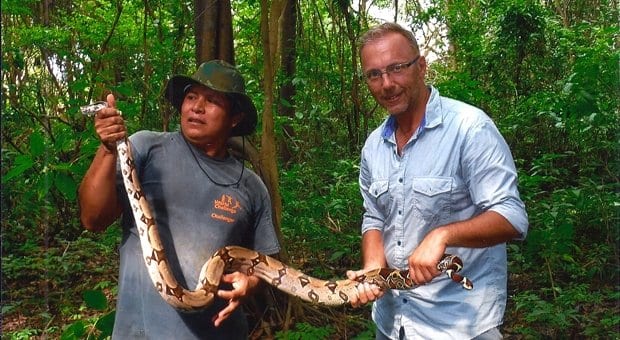
 Why you can trust Xtra
Why you can trust Xtra